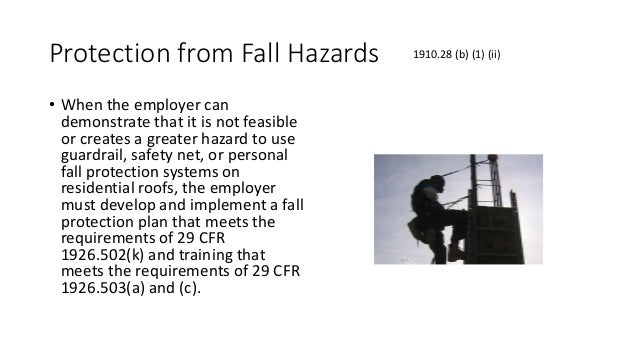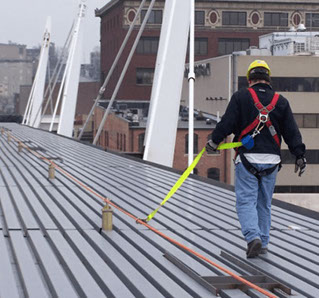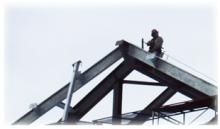Roof fall protection standards in regards specifically to roof fall protection the 1910 standard specifies for low slope roofs that when work is performed less than 6 feet 1 6 m from the roof edge the employer must ensure each employee is protected from falling by a guardrail system safety net system travel restraint system or personal fall arrest system.
Osha 1910 fall protection on roofs.
1910 28 b 13 iii a protect each employee from falling by a guardrail system safety net system travel restraint system or personal fall arrest system or a designated area.
The employer is not required to provide any fall protection provided the work is both infrequent and temporary.
Personal fall protection systems.
Except as otherwise provided in paragraph b of this section each employee engaged in roofing activities on low slope roofs with unprotected sides and edges 6 feet 1 8 m or more above lower levels shall be protected from falling by guardrail systems safety net systems personal fall arrest systems or a combination of warning line system and guardrail system warning line system and safety net system or warning line system and personal fall arrest system or warning line system and.
1910 29 k protection from falling objects.
The employer has the burden to establish that it is not feasible or will create a greater hazard to provide any fall protection in the particular residential roof operation and that it is permitted to implement a fall protection plan pursuant to 1910 28 b 1 ii.
1910 140 c 21 the employer must provide for prompt rescue of each employee in the event of a fall.
In contrast the rules in cfr 1926 for construction have included personal fall.
The osha regulations for fall protection in general industry in cfr 1910 have previously been limited to either eliminating any fall hazards by keeping the work tasks at ground level or by placing a barrier between the worker and the hazard such as guardrails.
Occupational safety health administration.
1910 140 c 22 personal fall protection systems must be worn with the attachment point of the body harness located in the center of the employee s back near shoulder level.
Grab bars not required at hatch exits.
08 30 1999 1910 23 osha s requirements for locking type snaphooks on pole strap systems 03 13 1996.
07 12 2000 1910 23 osha requires fall protection for elevator work when a fall hazard is present.
On low sloped roofs or an employee covered by a fall protection plan shall be allowed in an area where an employee is being protected by a safety monitoring system.
Fall protection systems required by this part shall comply with the applicable provisions of this section.

























